Design and Additive Manufacturing of a Continuous Servo Pneumatic Actuator
Abstract
:1. Introduction
1.1. Motivation
1.1.1. Lightweight Robotics
1.1.2. Pneumatic Devices for Continuous Rotation
1.1.3. Prototyping of Bellows Actuators
1.2. Contribution, Originality, and Organization of the Paper
2. Operating Principle
2.1. Conceptual Design
2.2. Actuator Torque
3. Design and Manufacturing
3.1. Linear Actuators
3.1.1. Material Model
3.1.2. Bellows Shape
3.1.3. Validation Experiment
3.1.4. Molding of Elastomer Bellows
3.2. Actuator Prototype
4. Experimental Validation
4.1. Experimental Setup and Procedure
4.2. Continuous Rotation
4.3. Positioning
4.4. Discussion of Experiments
5. Conclusions
Supplementary Materials
Author Contributions
Funding
Data Availability Statement
Acknowledgments
Conflicts of Interest
References
- Gealy, D.V.; McKinley, S.; Yi, B.; Wu, P.; Downey, P.R.; Balke, G.; Zhao, A.; Guo, M.; Thomasson, R.; Sinclair, A.; et al. Quasi-direct drive for low-cost compliant robotic manipulation. In Proceedings of the 2019 International Conference on Robotics and Automation (ICRA), Montreal, QC, Canada, 20–24 May 2019; pp. 437–443. [Google Scholar] [CrossRef]
- Gaiser, I.; Wiegand, R.; Ivlev, O.; Andres, A.; Breitwieser, H.; Schulz, S.; Bretthauer, G. Compliant Robotics and Automation with Flexible Fluidic Actuators and Inflatable Structures; IntechOpen: London, UK, 2012. [Google Scholar] [CrossRef]
- Festo AG & Co. KG. BionicCobot—Sensitive Helper for Human-Robot Collaboration. 2017. Available online: https://www.festo.com/net/SupportPortal/Files/462251/Festo_BionicCobot_en.pdf (accessed on 11 August 2023).
- Dämmer, G.; Gablenz, S.; Neumann, R.; Major, Z. Design, Topology Optimization, and Additive Manufacturing of a Pneumatically Actuated Lightweight Robot. Actuators 2023, 12, 266. [Google Scholar] [CrossRef]
- Mao, Z.; Peng, Y.; Hu, C.; Ding, R.; Yamada, Y.; Maeda, S. Soft computing-based predictive modeling of flexible electrohydrodynamic pumps. Biomim. Intell. Robot. 2023, 3, 100114. [Google Scholar] [CrossRef]
- Gorissen, B.; Reynaerts, D.; Konishi, S.; Yoshida, K.; Kim, J.-W.; De Volder, M. Elastic Inflatable Actuators for Soft Robotic Applications. Adv. Mater. 2017, 29, 1604977. [Google Scholar] [CrossRef] [PubMed]
- Polygerinos, P.; Correll, N.; Morin, S.A.; Mosadegh, B.; Onal, C.D.; Petersen, K.; Cianchetti, M.; Tolley, M.T.; Shepherd, R.F. Soft robotics: Review of fluid-driven intrinsically soft devices; manufacturing, sensing, control, and applications in human-robot interaction. Adv. Eng. Mater. 2017, 19, 1700016. [Google Scholar] [CrossRef]
- Walker, J.; Zidek, T.; Harbel, C.; Yoon, S.; Strickland, F.S.; Kumar, S.; Shin, M. Soft Robotics: A Review of Recent Developments of Pneumatic Soft Actuators. Actuators 2020, 9, 3. [Google Scholar] [CrossRef]
- Dämmer, G.; Bauer, H.; Neumann, R.; Major, Z. Design, additive manufacturing and component testing of pneumatic rotary vane actuators for lightweight robots. Rapid Prototyp. J. 2021, 28, 20–32. [Google Scholar] [CrossRef]
- Dämmer, G.; Lackner, M.; Laicher, S.; Neumann, R.; Major, Z. Design of an Inkjet-Printed Rotary Bellows Actuator and Simulation of its Time-Dependent Deformation Behavior. Front. Robot. AI 2021, 8, 663158. [Google Scholar] [CrossRef]
- Musser, C.W. Fluid Wave Generator for Harmonic Drive. U.S. Patent No. 3,088,333, 7 May 1963. [Google Scholar]
- Lewis, E.E. Rotary Hydraulic Drives. U.S. Patent No. 3,362,254, 9 January 1968. [Google Scholar]
- Stoianovici, D.; Kavoussi, L.R. Planetary Harmonic Motor. U.S. Patent No. 7,086,309, 8 August 2006. [Google Scholar]
- Cunningham, S. Radial Piston Engine with Guide Rollers. European Patent No. 1062426 B1, 2 October 2002. [Google Scholar]
- Bibus. Luftmotoren und Zubehör; Bibus GmbH: Neu-Ulm, Germany, 2019; Available online: https://www.bibus.de/fileadmin/editors/countries/biulm/product_data/bibus/documents/2019/BIBUS-Luftmotoren-und-Zubehoer-2019-190911.pdf (accessed on 11 August 2023).
- Atlas Copco. Air Motors; Atlas Copco Tools Central Europe GmbH: Essen, Germany, 2021; Available online: https://www.atlascopco.com/content/dam/atlas-copco/local-countries/germany/documents-industrial-technique/Motorenkatalog-2021.pdf (accessed on 11 August 2023).
- Cissell, T.J.; Doerschuk, D.C.; Koester, K.G.; Reed, G.K. Pneumatic Stepper Motor Actuator. U.S. Patent No. 5,060,539, 29 October 1991. [Google Scholar]
- Suzumori, K.; Hori, K.; Miyagawa, T. A direct-drive pneumatic stepping motor for robots: Designs for pipe-inspection microrobots and for human-care robots. In Proceedings of the 1998 IEEE International Conference on Robotics and Automation, Leuven, Belgium, 16–20 May 1998; Volume 4, pp. 3047–3052. [Google Scholar]
- Stoianovici, D.; Patriciu, A.; Petrisor, D.; Mazilu, D.; Kavoussi, L. A New Type of Motor: Pneumatic Step Motor. IEEE/ASME Trans. Mechatron. 2007, 12, 98–106. [Google Scholar] [CrossRef] [PubMed]
- Stoianovici, D.; Patriciu, A.; Mazilu, D.; Petrisor, D.; Kavoussi, L.R. Pneumatic Stepper Motor. U.S. Patent No. US 8,061,262 B2, 22 November 2011. [Google Scholar]
- Groenhuis, V.; Stramigioli, S. Rapid Prototyping High-Performance MR Safe Pneumatic Stepper Motors. IEEE/ASME Trans. Mechatron. 2018, 23, 1843–1853. [Google Scholar] [CrossRef]
- Gong, X.; Yang, K.; Xie, J.; Wang, Y.; Kulkarni, P.; Hobbs, A.S.; Mazzeo, A.D. Rotary Actuators Based on Pneumatically Driven Elastomeric Structures. Adv. Mater. 2016, 28, 7533–7538. [Google Scholar] [CrossRef]
- Rizk, N.M.; Danyo, G.D.; Mor, A.B. Fluid Rotary Joint and Method of Using the Same. Publication U.S. Patent Application 2017/0350492 A1, 2 June 2017. [Google Scholar]
- MacCurdy, R.; Katzschmann, R.; Kim, Y.; Rus, D. Printable hydraulics: A method for fabricating robots by 3D co-printing solids and liquids. In Proceedings of the 2016 IEEE International Conference on Robotics and Automation (ICRA), Stockholm, Sweden, 16–21 May 2016; pp. 3878–3885. [Google Scholar] [CrossRef]
- Neitzert, T.R. Accuracy of Additive Manufactured Parts. Key Eng. Mater. 2015, 661, 113–118. [Google Scholar] [CrossRef]
- Rebong, R.E.; Stewart, K.T.; Utreja, A.; Ghoneima, A.A. Accuracy of three-dimensional dental resin models created by fused deposition modeling, stereolithography, and Polyjet prototype technologies: A comparative study. Angle Orthod. 2018, 88, 363–369. [Google Scholar] [CrossRef] [PubMed]
- Gul, J.Z.; Sajid, M.; Rehman, M.M.; Siddiqui, G.U.; Shah, I.; Kim, K.-H.; Lee, J.-W.; Choi, K.H. 3D printing for soft robotics—A review. Sci. Technol. Adv. Mater. 2018, 19, 243–262. [Google Scholar] [CrossRef] [PubMed]
- Schmitt, F.; Piccin, O.; Barbé, L.; Bayle, B. Soft Robots Manufacturing: A Review. Front. Robot. AI 2018, 31, 84. [Google Scholar] [CrossRef]
- Wallin, T.J.; Pikul, J.; Shepherd, R.F. 3D printing of soft robotic systems. Nat. Rev. Mater. 2018, 3, 84–100. [Google Scholar] [CrossRef]
- Yap, Y.L.; Sing, S.L.; Yeong, W.Y. A review of 3D printing processes and materials for soft robotics. Rapid Prototyp. J. 2020, 26, 1345–1361. [Google Scholar] [CrossRef]
- Zolfagharian, A.; Kouzani, A.Z.; Khoo, S.Y.; Moghadam, A.A.A.; Gibson, I.; Kaynak, A. Evolution of 3D printed soft actuators. Sens. Actuators A Phys. 2016, 250, 258–272. [Google Scholar] [CrossRef]
- Sparrman, B.; du Pasquier, C.; Thomsen, C.; Darbari, S.; Rustom, R.; Laucks, J.; Shea, K.; Tibbits, S. Printed silicone pneumatic actuators for soft robotics. Addit. Manuf. 2021, 40, 101860. [Google Scholar] [CrossRef]
- Peele, B.N.; Wallin, T.J.; Zhao, H.; Shepherd, R.F. 3D printing antagonistic systems of artificial muscle using projection stereolithography. Bioinspiration Biomim. 2015, 10, 055003. [Google Scholar] [CrossRef]
- Drotman, D.; Ishida, M.; Jadhav, S.; Tolley, M.T. Application-Driven Design of Soft, 3-D Printed, Pneumatic Actuators with Bellows. IEEE/ASME Trans. Mechatron. 2018, 24, 78–87. [Google Scholar] [CrossRef]
- Dämmer, G.; Gablenz, S.; Hildebrandt, A.; Major, Z. PolyJet-Printed Bellows Actuators: Design, Structural Optimization, and Experimental Investigation. Front. Robot. AI 2019, 6, 34. [Google Scholar] [CrossRef]
- Abayazid, F.F.; Ghajari, M. Material characterisation of additively manufactured elastomers at different strain rates and build orientations. Addit. Manuf. 2020, 33, 101160. [Google Scholar] [CrossRef]
- Moore, J.P.; Williams, C.B. Fatigue properties of parts printed by PolyJet material jetting. Rapid Prototyp. J. 2015, 21, 675–685. [Google Scholar] [CrossRef]
- Kaweesa, D.V.; Meisel, N.A. Quantifying fatigue property changes in material jetted parts due to functionally graded material interface design. Addit. Manuf. 2018, 21, 141–149. [Google Scholar] [CrossRef]
- Marchese, A.D.; Katzschmann, R.; Rus, D.L. A Recipe for Soft Fluidic Elastomer Robots. Soft Robot. 2015, 2, 7–25. [Google Scholar] [CrossRef]
- Lawrence, A.B.; Alspach, A.N.; Bentivegna, D.C. Mechanical implementation of a variable-stiffness actuator for a softly strummed ukulele. In Proceedings of the 2016 IEEE/RSJ International Conference on Intelligent Robots and Systems (IROS), Daejeon, Republic of Korea, 9–14 October 2016; pp. 376–382. [Google Scholar] [CrossRef]
- Jung, W.; Kang, Y.; Han, S.; Hwang, Y. Biocompatible micro, soft bellow actuator rapidly manufactured using 3D-printed soluble mold. J. Micromech. Microeng. 2019, 29, 125005. [Google Scholar] [CrossRef]
- Ahn, S.; Jung, W.; Ko, K.; Lee, Y.; Lee, C.; Hwang, Y. Thermopneumatic Soft Micro Bellows Actuator for Standalone Operation. Micromachines 2021, 12, 46. [Google Scholar] [CrossRef] [PubMed]
- Galloway, K.C.; Becker, K.P.; Phillips, B.; Kirby, J.; Licht, S.; Tchernov, D.; Wood, R.J.; Gruber, D.F. Soft Robotic Grippers for Biological Sampling on Deep Reefs. Soft Robot. 2016, 3, 23–33. [Google Scholar] [CrossRef]
- Svetozarevic, B.; Begle, M.; Caranovic, S.; Nagy, Z.; Schlueter, A. Quick-Cast: A Method for Fast and Precise Scalable Production of Fluid-Driven Elastomeric Soft Actuators. 2019. Available online: http://arxiv.org/abs/1810.05920 (accessed on 11 August 2023).
- Smooth-On, Inc. PMC-780 Dry & PMC-780 Wet, Industrial Liquid Rubber Compounds; Smooth-On, Inc.: Macungie, PA, USA, 2021; Available online: https://www.smooth-on.com/tb/files/PMC-780_Dry-Wet.pdf (accessed on 11 August 2023).
- DIN, ENISO. DIN EN ISO 527-2: 2012-06 Plastics–Determination of Tensile Properties–Part 2: Test Conditions for Moulding and Extrusion Plastics (ISO 527-2:2012) German Version; Beuth Verlag: Berlin, Germany, 2012. [Google Scholar] [CrossRef]
- Çakmak, U.D.; Hiptmair, F.; Major, Z. Applicability of elastomer time-dependent behavior in dynamic mechanical damping systems. Mech. Time-Dependent Mater. 2013, 18, 139–151. [Google Scholar] [CrossRef]
- Dassault Systèmes Simulia Corp. Abaqus/CAE User’s Guide. Version 6.14; Dassault Systèmes Simulia Corp.: Providence, RI, USA, 2014. [Google Scholar]
- Dassault Systèmes Simulia Corp. Abaqus Theory Guide. Version 6.14; Dassault Systèmes Simulia Corp.: Providence, RI, USA, 2014. [Google Scholar]
- Bergström, J.S. Mechanics of Solid Polymers: Theory and Computational Modeling; William Andrew Publishing: San Diego, CA, USA, 2015. [Google Scholar] [CrossRef]
- Smooth-On, Inc. Safety Data Sheet SDS No. 615; Smooth-On, Inc.: Macungie, PA, USA, 2021; Available online: https://www.smooth-on.com/msds/files/PMC-780.pdf (accessed on 11 August 2023).

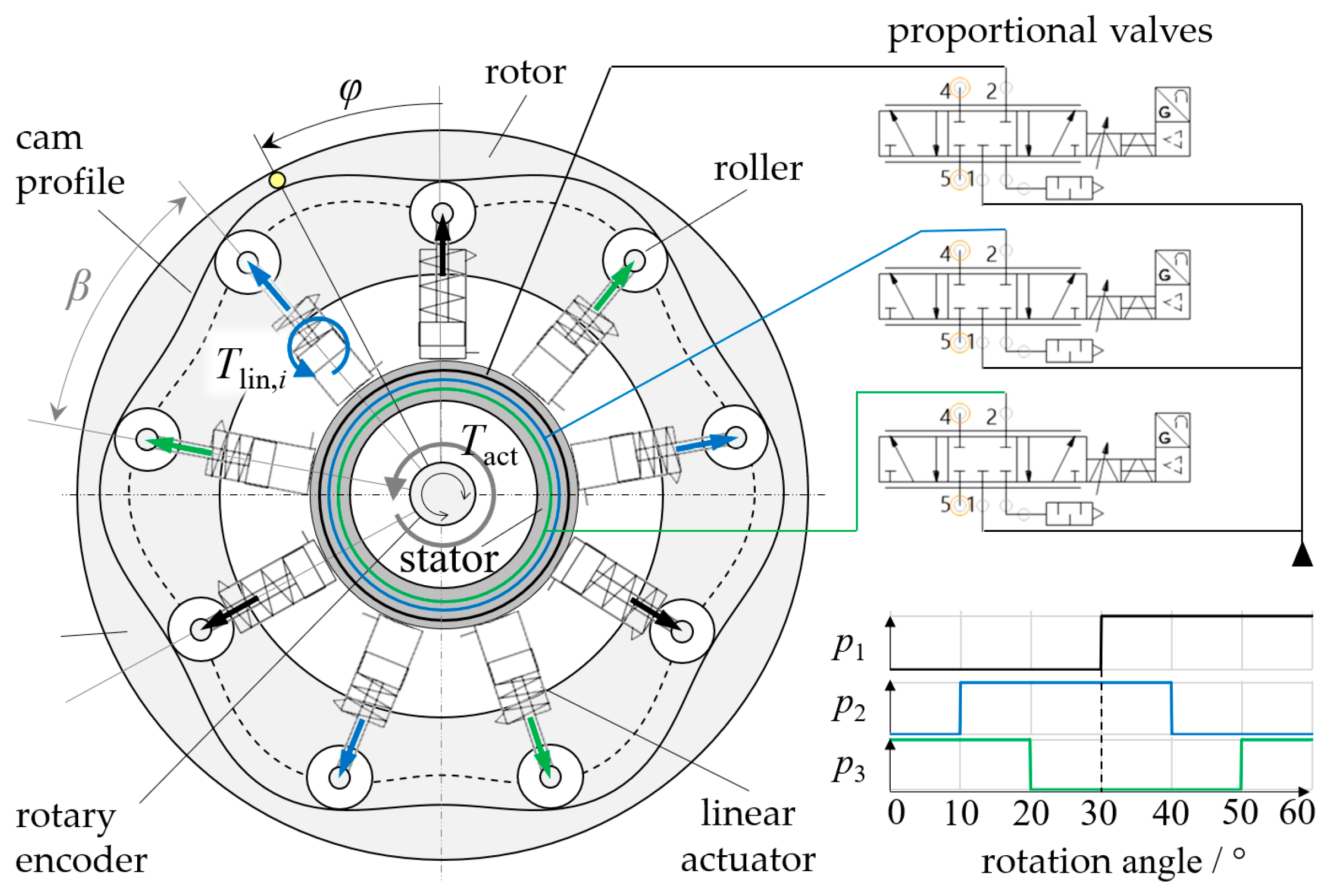
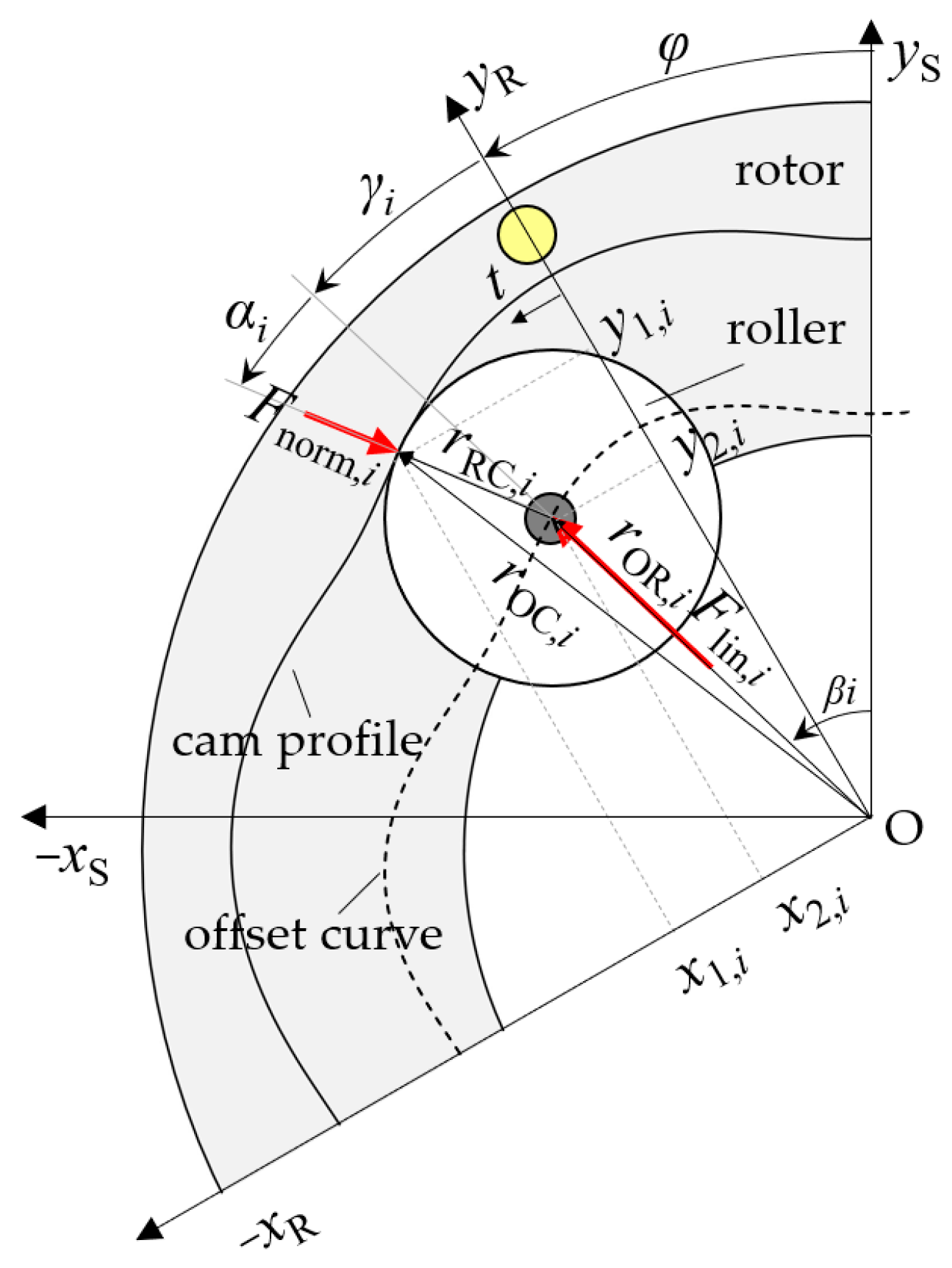
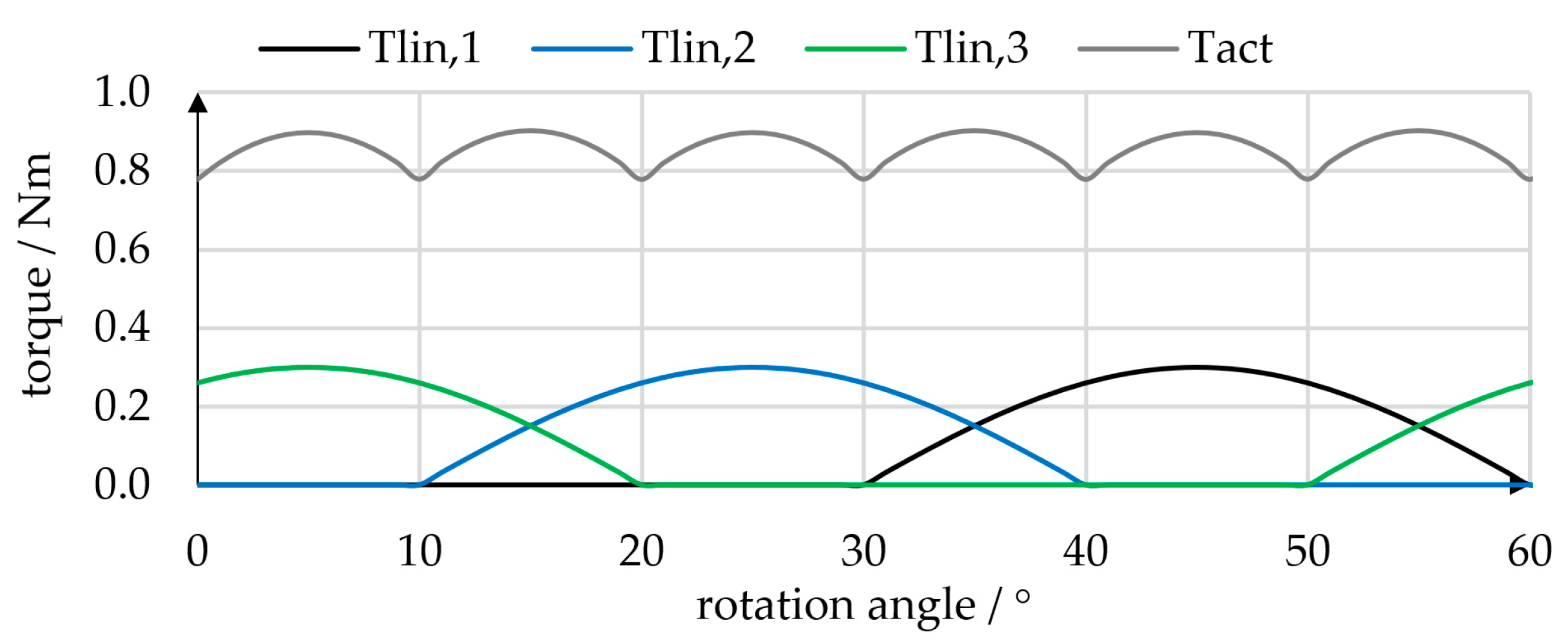
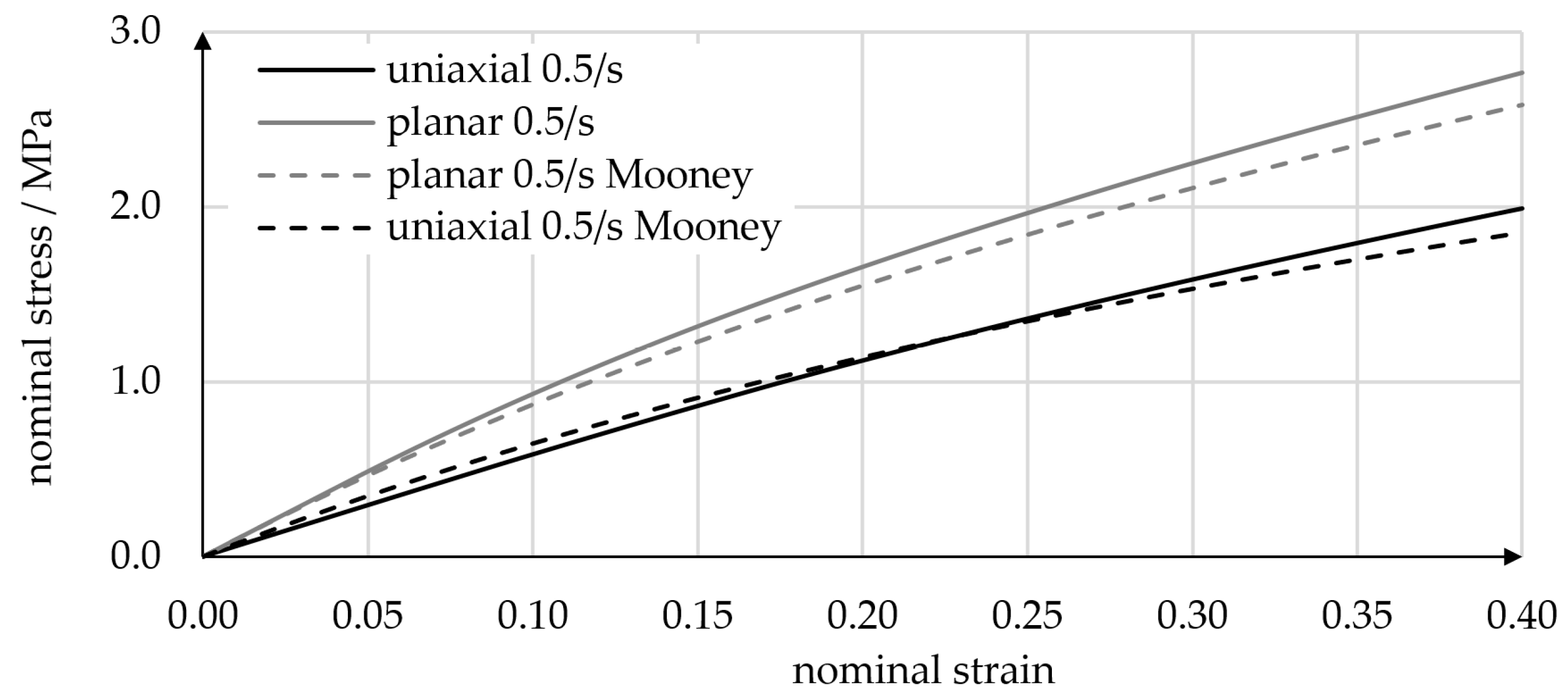

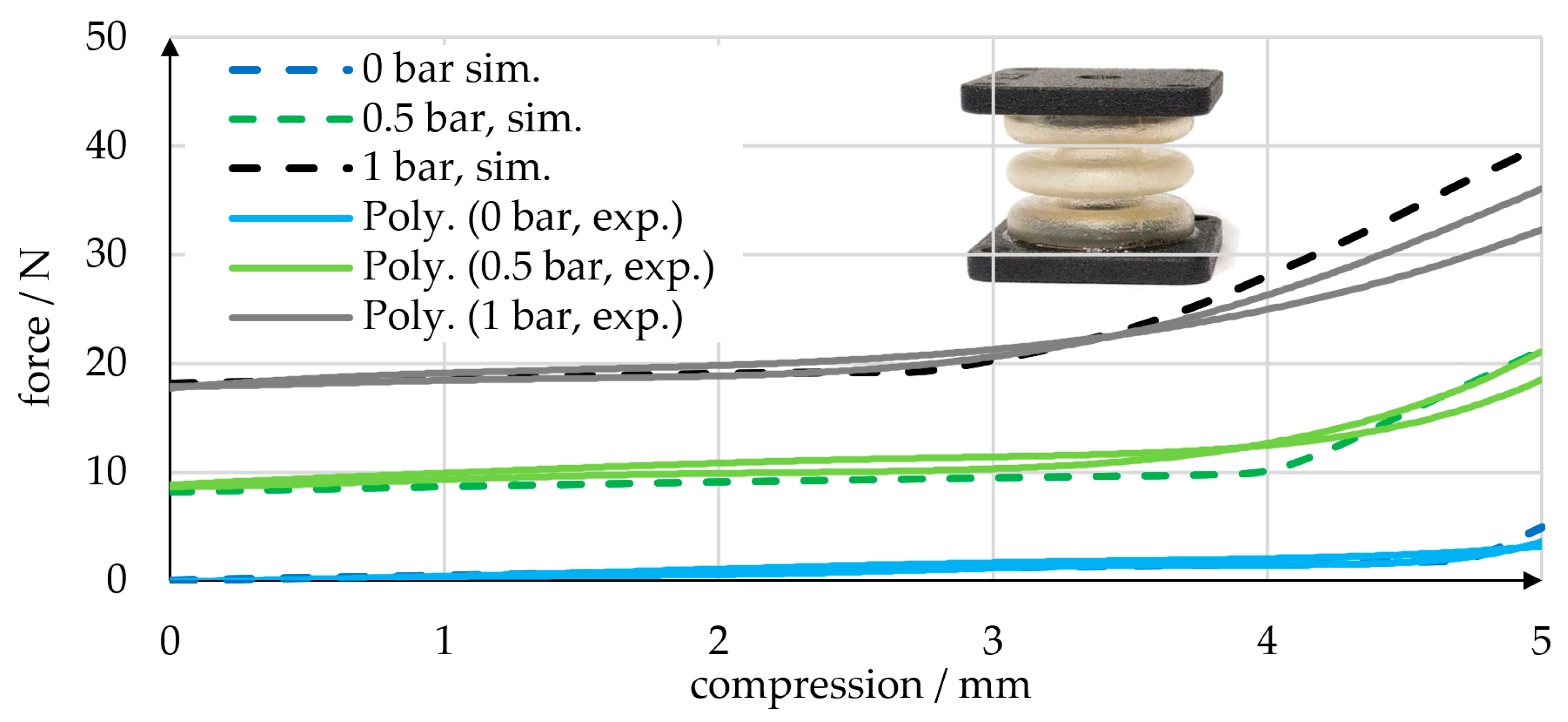
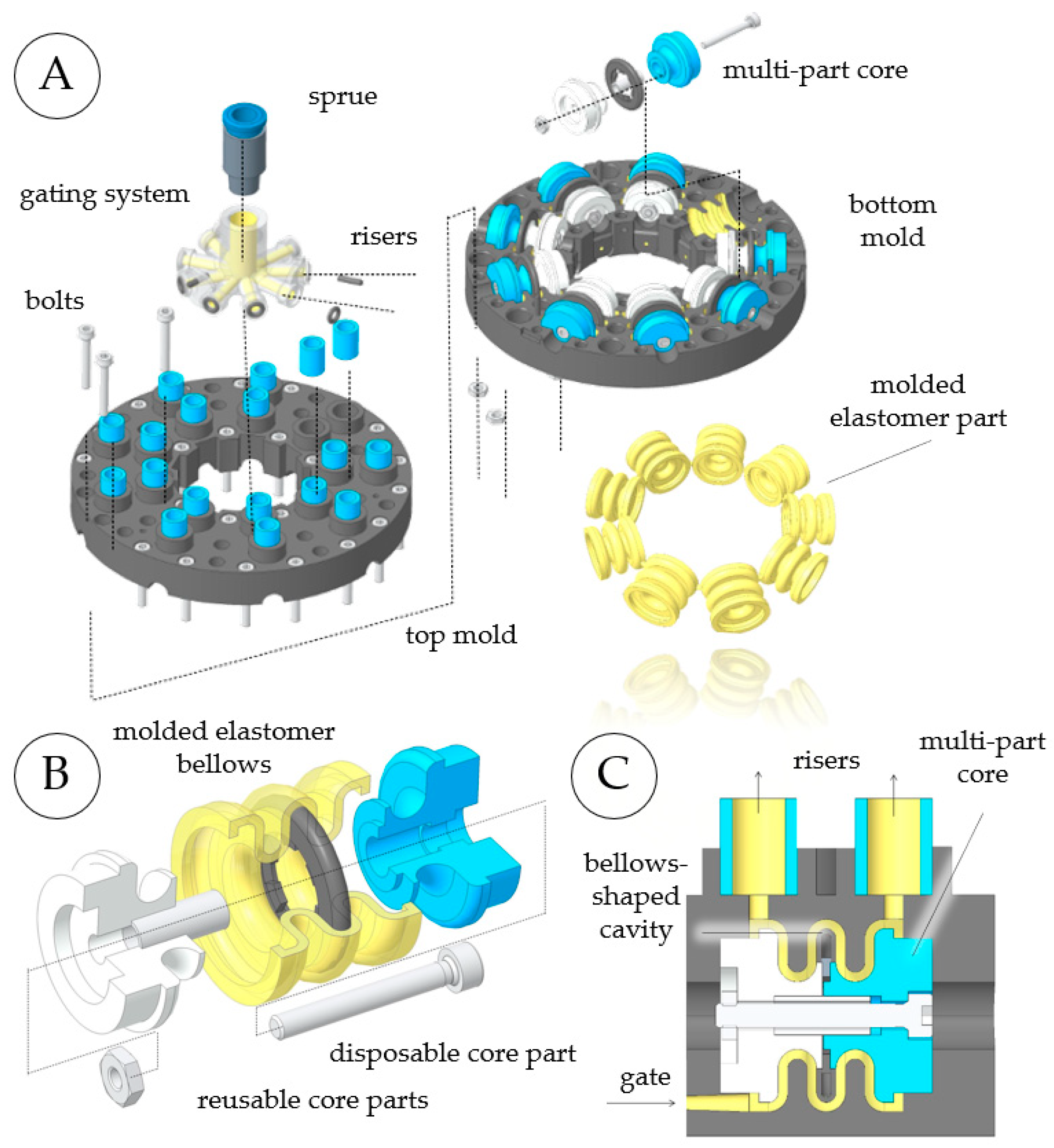
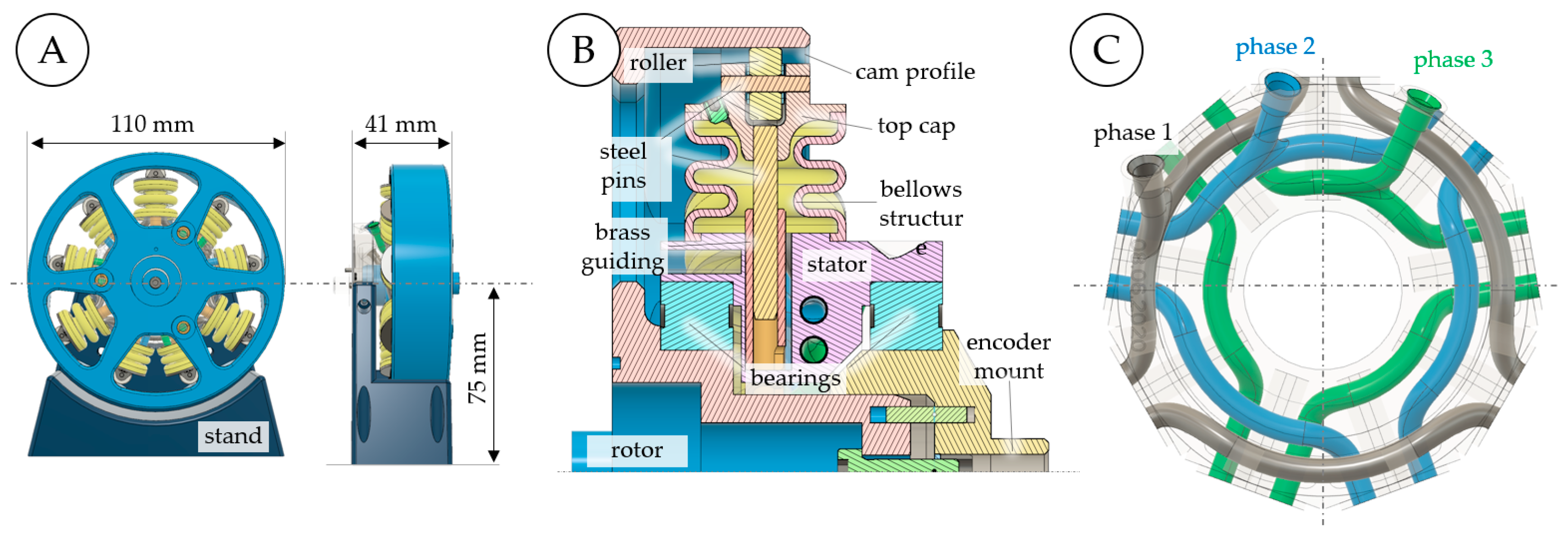
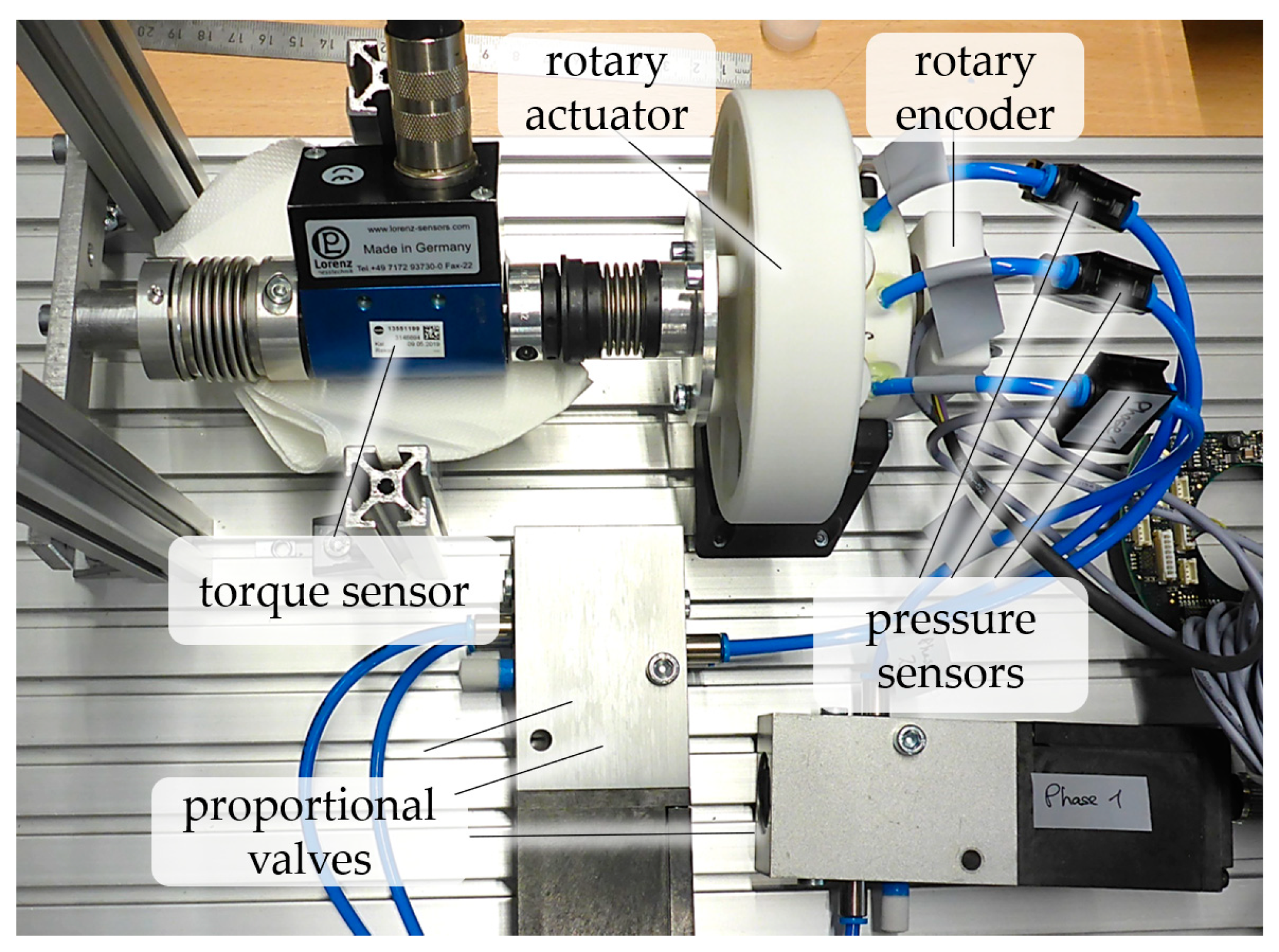


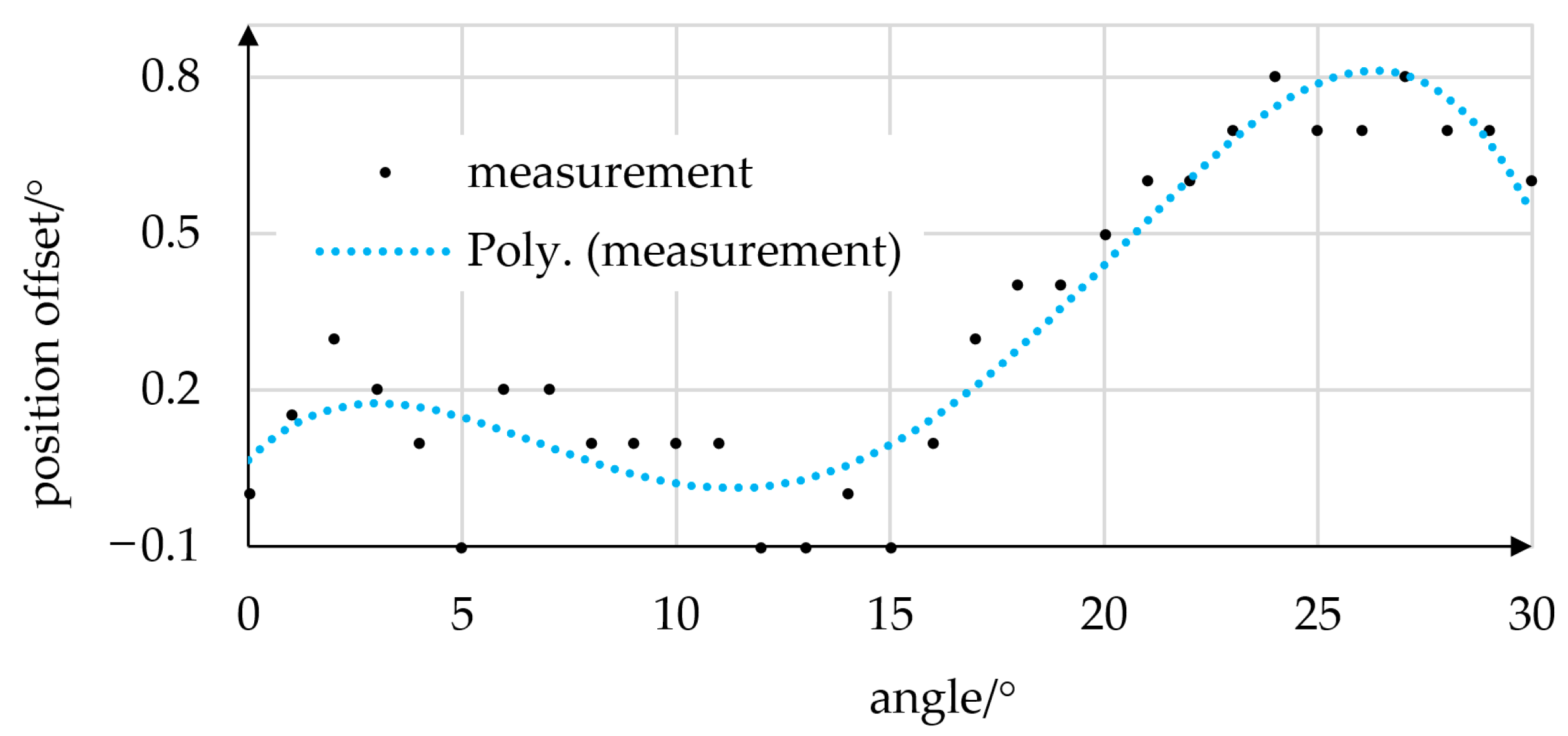
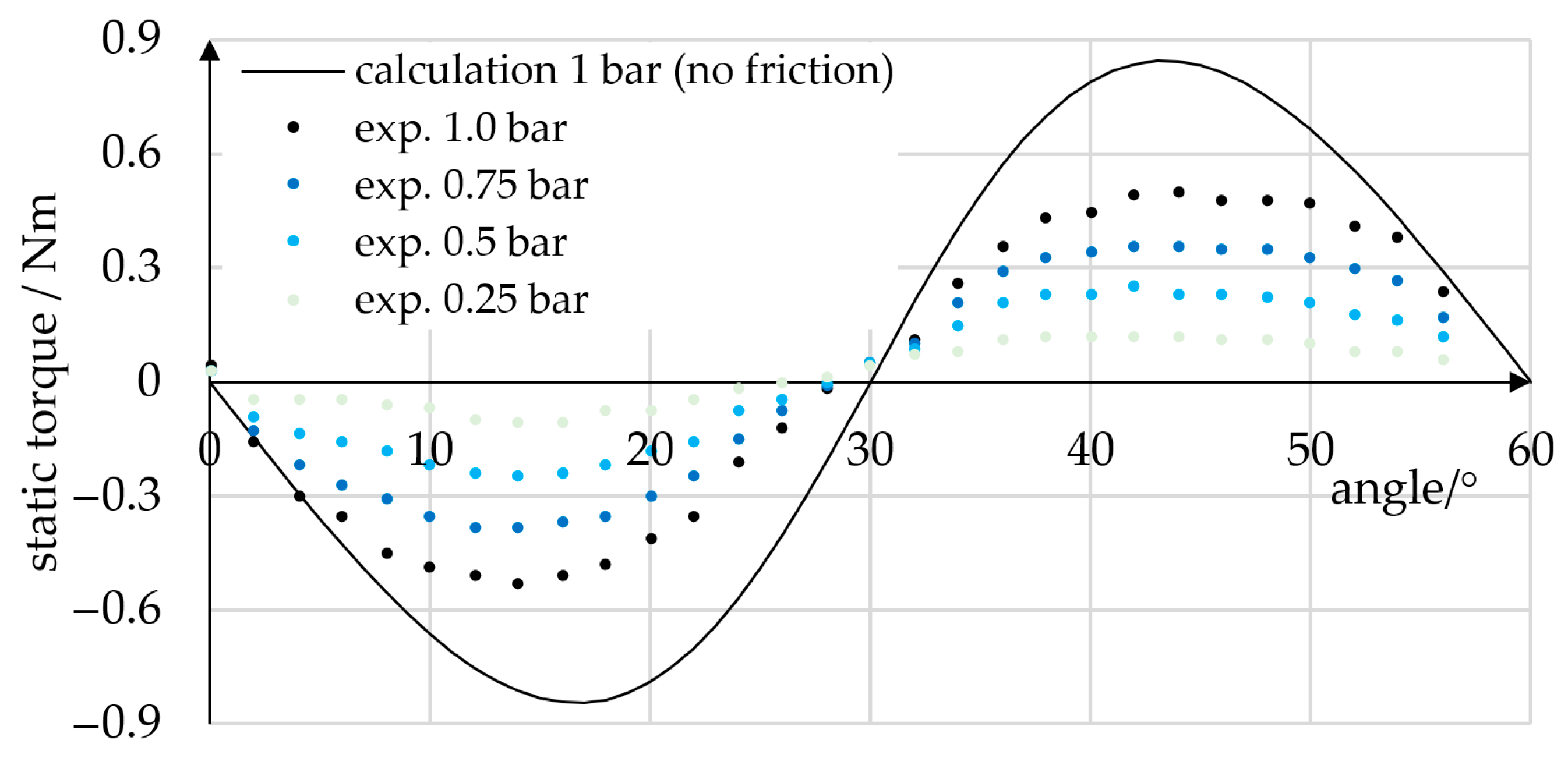
Disclaimer/Publisher’s Note: The statements, opinions and data contained in all publications are solely those of the individual author(s) and contributor(s) and not of MDPI and/or the editor(s). MDPI and/or the editor(s) disclaim responsibility for any injury to people or property resulting from any ideas, methods, instructions or products referred to in the content. |
© 2023 by the authors. Licensee MDPI, Basel, Switzerland. This article is an open access article distributed under the terms and conditions of the Creative Commons Attribution (CC BY) license (https://creativecommons.org/licenses/by/4.0/).
Share and Cite
Dämmer, G.; Bauer, H.; Lackner, M.; Neumann, R.; Hildebrandt, A.; Major, Z. Design and Additive Manufacturing of a Continuous Servo Pneumatic Actuator. Micromachines 2023, 14, 1622. https://doi.org/10.3390/mi14081622
Dämmer G, Bauer H, Lackner M, Neumann R, Hildebrandt A, Major Z. Design and Additive Manufacturing of a Continuous Servo Pneumatic Actuator. Micromachines. 2023; 14(8):1622. https://doi.org/10.3390/mi14081622
Chicago/Turabian StyleDämmer, Gabriel, Hartmut Bauer, Michael Lackner, Rüdiger Neumann, Alexander Hildebrandt, and Zoltán Major. 2023. "Design and Additive Manufacturing of a Continuous Servo Pneumatic Actuator" Micromachines 14, no. 8: 1622. https://doi.org/10.3390/mi14081622




